Video on Problems on H.C.F and L.C.M - shortcuts, tips and tricksH.C.F and L.C.M of numbers
Why is H.C.F and L.C.M important? The chapter of H.C.F and L.C.M is very important. This concept is useful in the chapters of time and distance, time and work, pipes and cisterns, etc. The tricks used to find
L.C.M and H.C.F of two or more numbers help in finding out quick solutions and thus reduce time during exams.
L.C.M. concept is important to solve problems related to racetracks, traffic lights, etc.
H.C.F. concept is useful in calculating the largest size of tile/room in particular area, largest tape to measure the land, etc.
Important terms: 1) Factors: Factor is a number which
exactly divides other number. Example: 3 and 5 are factors of 15
2) Multiple: A number is said to be multiple of another number, when it is
exactly divisible by other number. Example: 15 is a multiple of 3 and 5
3) Common multiple: A common multiple of two or more numbers is a number which is exactly divisible by each of them.
Example: 18 is a common multiple of 2,3,6 and 9
4) H.C.F/G.C.F: (Highest Common Factor / Greatest Common Factor). H.C.F of two or more numbers is the greatest number which divides each number exactly.
5) L.C.M.: (Lowest common multiple). The least number exactly divisible by each one of the given numbers is called least common multiple.
Points To Remember: 1) Before studying this chapter, make sure that the basic concepts of numbers (prime numbers, composite numbers, co-prime numbers, etc) are perfectly understood. Knowing basics will help in understanding this chapter.
Quick Revision of prime numbers, composite numbers and co-prime numbers is given below:
 2)
2) (H.C.F)
a) It is the greatest number which exactly divides all the given numbers.
b) The H.C.F of two or more numbers is smaller than or equal to the smallest number of given numbers.
c) H.C.F of given numbers divides their L.C.M.
d) Two numbers are said to be co-prime if their H.C.F. is 1.
3) (L.C.M)
a) To find L.C.M. of two co-prime numbers, just multiply the given two numbers.
b) The L.C.M. of two or more numbers is greater than or equal to greatest number of given numbers.
Methods to Find H.C.F. of Given Numbers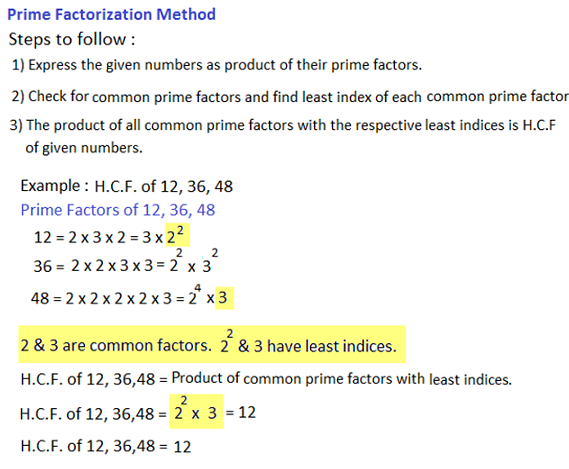
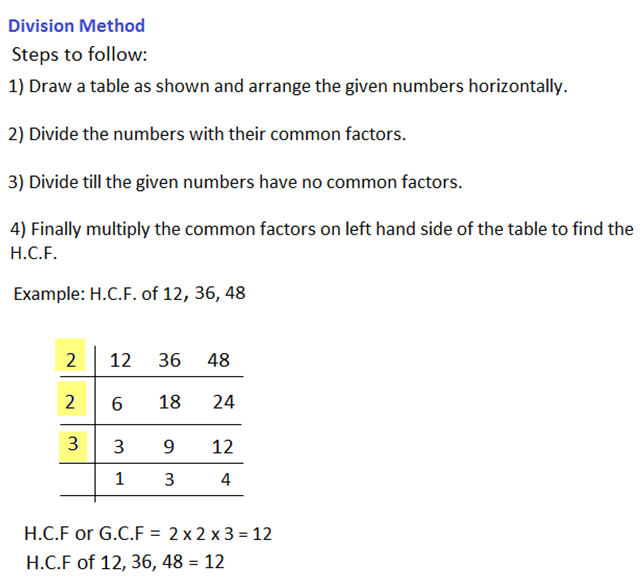
 Methods to Find L.C.M. of Given Numbers
Methods to Find L.C.M. of Given Numbers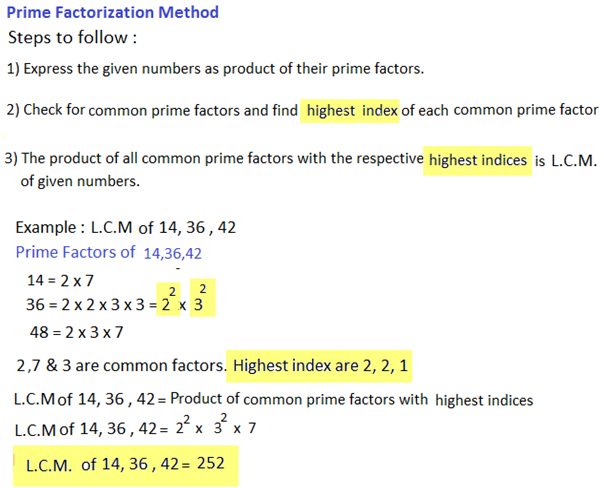
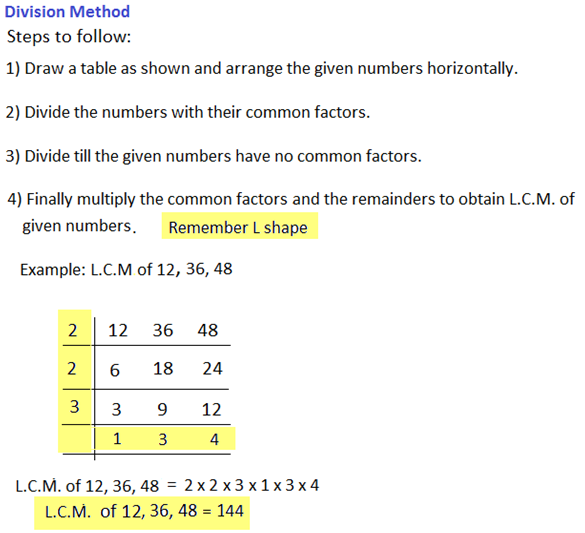
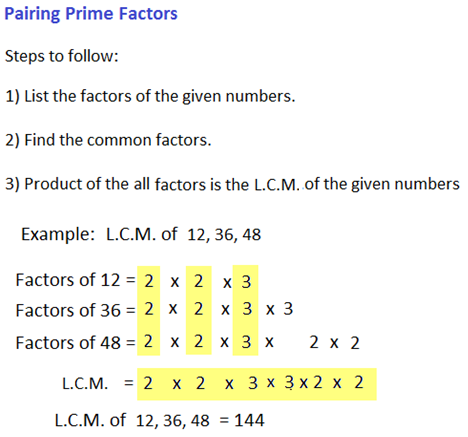 Tips and Tricks: 1) H.C.F. and L.C.M. of Fractions
Tips and Tricks: 1) H.C.F. and L.C.M. of Fractions| a) H.C.F. = | H.C.F. of Numerator |
| L.C.M. of Denominator |
Example | H.C.F. of | l | , | m | , | n | = | H.C.F. of (l, m, n) |
| a | b | c | L.C.M. of (a, b, c) |
| b) L.C.M. = | L.C.M. of Numerator |
| H.C.F. of Denominator |
| L.C.M. of | l | , | m | , | n | = | L.C.M. of (l, m, n) |
| a | b | c | H.C.F. of (a, b, c) |
2) Product of two numbers = Product of their H.C.F. and L.C.M. This condition is only true for two given numbers. If H.C.F. and L.C.M. of three or more numbers are given, then this rule is not applicable. 3) H.C.F. and L.C.M. of decimal fractions: To find H.C.F. or L.C.M. of 0.5, 1.6, etc, consider these numbers without decimal point i.e 5, 16 and solve using normal methods used to determine H.C.F. or L.C.M.. In the result, mark off as many decimal places as there are in each of the given number.
4) Comparison of fractions: Find L.C.M. of denominators of given fractions. Convert each fraction into equivalent fraction with L.C.M. as denominator, by multiplying both numerator and denominator by same number. The resultant fraction with the greatest numerator is greatest.
Question Variety: Generally 5 types of questions are asked in this chapter. Understanding and studying these concepts will in solving this chapter as well as help in solving some topics in other chapters. Type 1: Find H.C.F. and L.C.M of composite numbers
H.C.F. of 513, 1134 and 1215 is _____________
a. 18
b. 27
c. 33
d. 36
View solution Correct Option: (b)
We know different methods to calculate H.C.F.
Finding H.C.F. by division method:
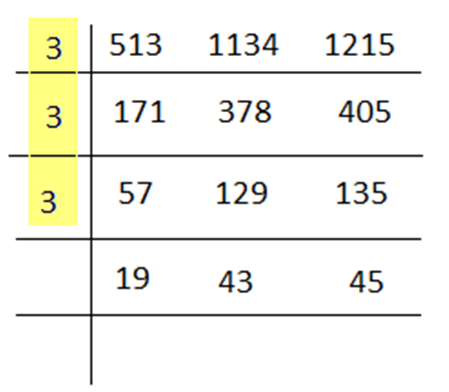
H.C.F. of 513, 1134 and 1215 = 3 × 3 × 3 = 27
Find the least number which is exactly divisible by 12, 15, and 20.
a. 40
b. 50
c. 60
d. 80
View solution Correct Option: (c)
Remember: The question may be asked in a tricky way.
Least number = L.C.M. of 12, 15, and 20. We have to find the least number.
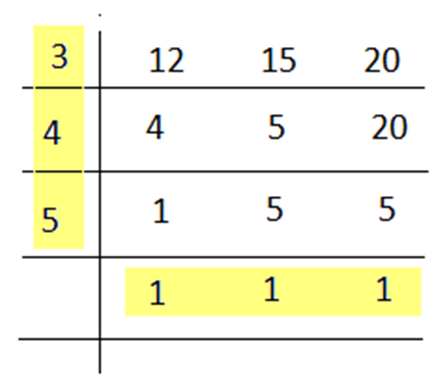
In this case, 20 is not divisible by 3, hence, write down as it is. 20 is further divisible by 4.
L.C.M. = 3 × 4 × 5 × 1 × 1 × 1 = 60
Hence, the required least number = 60
Find the largest number of 4-digits divisible by 12, 15 and 18.
a. 9900
b. 9750
c. 9450
d. 9000
View solution Correct Option: (a)
Largest 4-digit number is 9999.
Remember: The question may be asked in a tricky way. Here, largest number does not mean H.C.F.. We have to find a number which is divisible by 12, 15 and 18
Required largest number must be divisible by the L.C.M. of 12, 15 and 18
L.C.M. of 12, 15 and 18
12 = 2 × 2 × 3
15 =5 × 3
18 = 2 × 3 × 3
L.C.M. = 180
Now divide 9999 by 180, we get remainder as 99
The required largest number = (9999 – 99) =9900
Number 9900 is exactly divisible by 180.